

The
Research Project
The Study Area
Background Information
Tools Of The Trade
A Day In The Life Of . . .
Vegetation Plot Surveys
Questions, questions, questions....
What type of trees do the monkeys prefer? Are there similarities between the various vegetation plots? Are there differences? Are there patterns within the random plots? These are all the questions Lindsay is hoping to answer by doing vegetation surveys.
Whenever Lindsay finds monkeys she marks the spot with either a red ribbon or by recording the longitude and latitude with her GPS. This way she can return to the same spot and do a vegetation survey. The purpose of a vegetation survey is to attempt to discover if a relationship exists between where monkeys are found and what types of plants, terrain, and canopy cover exist there.
A vegetation survey begins by standing at the first location
where the monkeys were spotted. From this position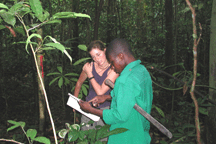 Lindsay measures out a distance of 10 meters in all four cardinal directions
(North, South, West and East). This is done by using a rope that is exactly
the right length, a compass and another person. That other person is John!
He always accompanies her when she does these surveys. His knowledge of
the plants found in the forest is essential (not to mention, amazing) when
trying to record tree species in the plot.
Lindsay measures out a distance of 10 meters in all four cardinal directions
(North, South, West and East). This is done by using a rope that is exactly
the right length, a compass and another person. That other person is John!
He always accompanies her when she does these surveys. His knowledge of
the plants found in the forest is essential (not to mention, amazing) when
trying to record tree species in the plot.
Once a distance has been measured with the rope. a red ribbon is tied to the nearest tree. This is repeated four times until there is a square formed by the ribbons. This 100 square meter area becomes the vegetation plot.
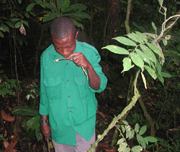 Every
tree above 1.5 meters must be recorded on a data sheet attached to a clipboard
Lindsay carries. This is where John becomes critical. In order to determine
the species type, he first looks at the leaves of the tree and the bark.
Then he uses his cutlass (machete) to cut a small piece of the bark away.
By looking at the inside of the bark and by smelling it he can identify
99% of all species. If John can't positively identify the tree, he and Lindsay
refer to the taxonomic key which is a book of tree species native to the
region.
Every
tree above 1.5 meters must be recorded on a data sheet attached to a clipboard
Lindsay carries. This is where John becomes critical. In order to determine
the species type, he first looks at the leaves of the tree and the bark.
Then he uses his cutlass (machete) to cut a small piece of the bark away.
By looking at the inside of the bark and by smelling it he can identify
99% of all species. If John can't positively identify the tree, he and Lindsay
refer to the taxonomic key which is a book of tree species native to the
region.
Once a tree has been identified it is marked on the data sheet
according to its species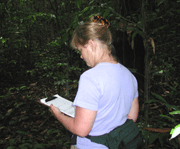 and the diameter of its trunk. The species is in a four letter code. The
letters are the first two letters of the genus followed by the first two
letters of the species. The measurement is taken at breast height with a
DBH (Diameter at Breast Height) tape. You may want to review Tools
of the Trade to read about the instruments Lindsay is using.
and the diameter of its trunk. The species is in a four letter code. The
letters are the first two letters of the genus followed by the first two
letters of the species. The measurement is taken at breast height with a
DBH (Diameter at Breast Height) tape. You may want to review Tools
of the Trade to read about the instruments Lindsay is using.
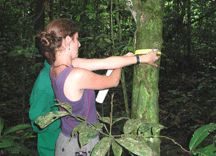 The
date, time, weather, temperature, location of the plot, and the type of
forest are all recorded on the data sheet. Lindsay also records the degree
of canopy cover using a densiometer and how "viney" the plot is. This
is just a visual observation of the plot. She notes any emergent trees (those
that extend above the canopy layer) and any indication of human disturbance.
The
date, time, weather, temperature, location of the plot, and the type of
forest are all recorded on the data sheet. Lindsay also records the degree
of canopy cover using a densiometer and how "viney" the plot is. This
is just a visual observation of the plot. She notes any emergent trees (those
that extend above the canopy layer) and any indication of human disturbance.
Depending upon how dense the vegetation is in the plot, a survey can take up to 1.5 hours.
Random Surveys
After she and John have completed the vegetation plot, they must then do the same thing all over again but with a completely random plot. This is important because when she begins to analyze her data she will compare where monkeys were found with areas where they were not. This way she can see if there are common plant types, similar canopy cover, etc. in the plots she finds monkeys. Without the random plot, there would be no baseline comparisons.
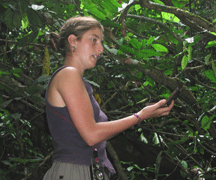 To determine a completely random sample, starting from the center of the
original plot, Lindsay starts her stopwatch and lets it run for a random
amount of time. This number is divided in half and that is the degrees (bearing)
she walks using her compass. She starts the stopwatch again and that number
is the number of paces she walks on the random compass bearing. For example
one day we walked 48 paces at 60 degrees. This becomes the center of her
random plot. She never places her random plot in an area that the monkeys
traveled through (approaching or fleeing) when they were sighted.
To determine a completely random sample, starting from the center of the
original plot, Lindsay starts her stopwatch and lets it run for a random
amount of time. This number is divided in half and that is the degrees (bearing)
she walks using her compass. She starts the stopwatch again and that number
is the number of paces she walks on the random compass bearing. For example
one day we walked 48 paces at 60 degrees. This becomes the center of her
random plot. She never places her random plot in an area that the monkeys
traveled through (approaching or fleeing) when they were sighted.
Survey Data
Below are Adobe Acrobat files of the vegetation plots she has done. You will need Adobe Acrobat Reader to view these files.
Vegetation Plot Survey December 7, 2001
Random Survey December 7, 2001
Vegetation Plot Survey December 8, 2001
Random Survey December 8, 2001